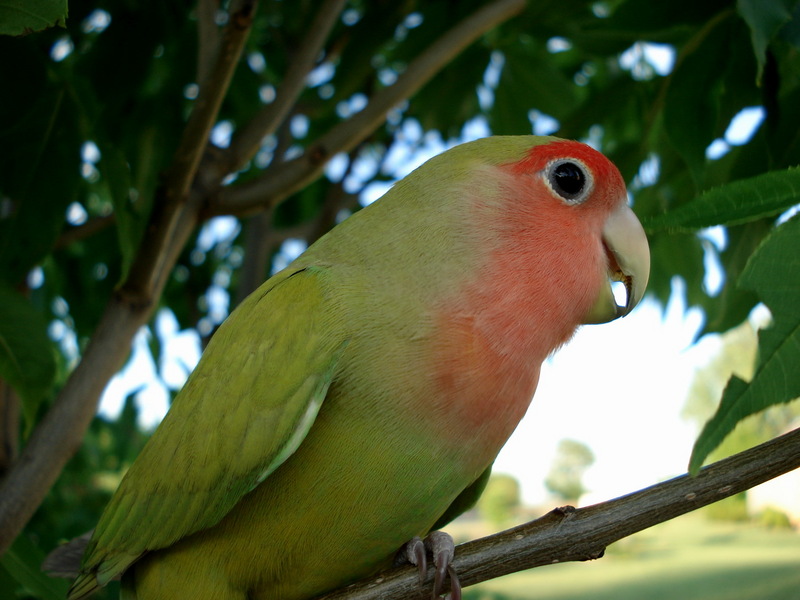|
| 질의: agapornis roseicollis | 결과: 2번째/13 | |
Peach-faced Lovebird (Agapornis roseicollis) - Wiki
| 제목: | Peach-faced Lovebird (Agapornis roseicollis) - Wiki
| |

| 해상도: 1408x1056
파일크기: 397117 Bytes
촬영일: 2006:05:29 20:19:11
사진기: DSC-W50 (SONY)
F number: f/2.8
Exposure: 10/1600 sec
Focal Length: 63/10
등록시간: 2007:08:10 14:08:01
|
Peach-faced Lovebird
From Wikipedia, the free encyclopedia
[Photo] A peachfaced lovebird (Agapornis roseicollis). Date 2006-08-13-18-40 (UTC). Author Nbansal4732 http://en.wikipedia.org/wiki/en:User:Nbansal4732
The Peach-faced Lovebird (Agapornis roseicollis), also known as the Rosy-faced Lovebird, is a species of lovebird native to arid regions in southwestern Africa such as the Namib Desert. A loud and constant chirper, these birds are very social animals and often congregate in small groups in the wild. They eat throughout the day and take frequent baths. Coloration can vary widely among populations but females are generally darker and greener, whilst males are smaller and brighter. Lovebirds are renowned for their sleep position in which they sit side-by-side and turn their faces in towards each other. Also, females are well noted to tear raw materials into long strips, "twisty-tie" them onto their backs, and fly distances back to make a nest.
Aviculture
Housing
Lovebirds, being an active bunch, need some room to move in their cage. A cage approximately 24" W x 14" D x 30" H (60 W x 35 D x 75 H cm) is a good size, but if you can afford it, the bigger the better. Make sure the bars are spaced no wider than 3/8" (1 cm) apart, otherwise your bird will be able to stick its head through the bars. Add a variety of perches, so your lovebird can excerise its feet to prevent arthritis. The perches should be at least 4" (10 cm) long and 1/2" (13 mm) in diameter. Also, a variety of different toys should be placed in the cage to prevent your bird from boredom and loneliness. Do not get your lovebird parakeet toys, because they can tear them apart easily. Try getting cockatiel toys that are more durable. Do not get toys with small bells, because your lovebird can get them stuck in its throat.
Feeding
Peachfaced lovebirds thrive when fed the proper diet. They should be fed a wide variety of active food, including vegetables, whole grains, and fruits. They are not to be fed dairy products, like chocolate and cheese. Carrots, beans, squash, and corn are excellent foods that provide healthy proteins. Grains should include millet, quinoa, winterwheat, and others. Except strawberries (which contain trace amounts of carcinogenic pesticides) feed lovebirds a rare treat of fresh fruit. Many are attuned to the taste of grapes. These birds also eat various seeds, pellets, and pastas. While seeds and pellets are easy to give to birds, they are not part of their natural diet and should be used in conjunction with vegetables. Good seed and pellet mixes include a large array of different seed types. Be sure to change any perishable food within a few hours of placing it in their housing or at the maximum within one day.
Personality
Peachfaced love birds get their name for their affection towards their owner or other birds. Lovebirds are very playful and love to have all the attention centered around them. If trained correctly, peachedfaced lovebirds will happily perch on your shoulder. All lovebirds are unique; they all have different temperaments. Some are calmer than others, while some are the most stubborn creatures you will ever meet. One thing you will find in every lovebird is that they need companionship. If you cannot provide attention, you will be suggested to purchase another one. But be warned: If you buy two lovebirds, they may not interact with you as much as if they were by themselves.
Breeding
Breeding these animals, like many other birds, is a task for advanced care-takers only. You must provide your soon-to-be mother bird with plenty of space and clean food each day.
http://en.wikipedia.org/wiki/Peach-faced_Lovebird
| The text in this page is based on the copyrighted Wikipedia article shown in above URL. It is used under the GNU Free Documentation License. You may redistribute it, verbatim or modified, providing that you comply with the terms of the GFDL. |
|
 |

|

|
agapornis roseicollis
2/13 |

|

|
^o^
동물그림창고 똑똑전화 누리집
^o^
|
|

